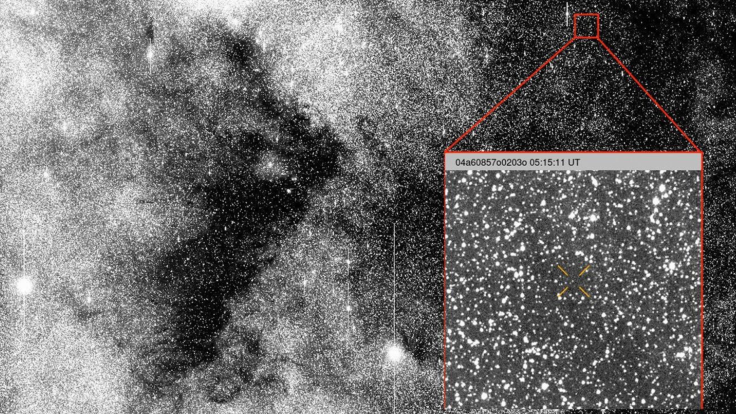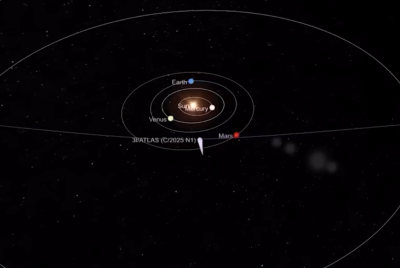December 19 Close Approach: ESA Confirms 3I/ATLAS Path Is Safe For Earth
ESA confirms 3I/ATLAS is safe for its Dec 19 close approach after an unprecedented tracking breakthrough.

Imagine catching a fleeting glimpse of a visitor from beyond your known neighbourhood, a traveller moving at impossible speeds, and then trying to plot its exact route. That's the challenge astronomers faced with 3I/ATLAS, the third confirmed interstellar object (ISO) ever observed passing through our Solar System.
Since its initial sighting on 1 July 2025 by astronomers at the Gemini South Observatory, the global scientific community has raced to constrain its origin and accurately predict its next destination.
This complex astronomical tracking exercise achieved a remarkable breakthrough thanks to an innovative approach using data provided by the European Space Agency's (ESA) ExoMars Trace Gas Orbiter (TGO), currently circling Mars.
The object is formally designated 3I/ATLAS because it is the third (3) interstellar (I) object detected by the Asteroid Terrestrial-impact Last Alert System (ATLAS) survey telescope. The two previous interstellar visitors were the oddly-shaped 1I/'Oumuamua, discovered in 2017, and the comet 2I/Borisov, discovered in 2019.
3I/ATLAS is confirmed to be a comet due to its observable activity (outgassing), and its trajectory is highly hyperbolic, meaning it is unbound to the Sun's gravity and will escape the Solar System forever.
The ability to accurately trace the comet's path isn't just an academic exercise; it provides a valuable test case for planetary defence. Knowing an object's precise trajectory is the only way to determine if a comet or asteroid poses a threat to Earth.
Before October, when 3I/ATLAS made its closest approach to Mars (coming within 29 million km or 18 million mi), its location could only be tracked by ground-based telescopes. However, when 3I/ATLAS flew past the red planet, the ESA's ExoMars TGO and Mars Express orbiters were perfectly positioned to view the comet from an entirely different angle.

Martian Orbiters and the 3I/ATLAS Trajectory Challenge
Capturing 3I/ATLAS was no simple feat, as both orbiters' main imaging cameras were originally designed to study brightly lit features on the Martian surface from orbit.
For example, the TGO's Colour and Stereo Surface Imaging System (CaSSIS) had to pivot from taking pictures of Mars to trying to capture a small, dark object roughly 30 million km (18.64 million mi) away.
This task was compounded by the fact that the team had to precisely account for TGO's movement as it orbited at speeds of up to 14,000 km/h (8,700 mph) while trying to snap the interstellar visitor.
This demanding assignment was ultimately managed by the planetary defence team at the ESA's Near-Earth Object Coordination Center (NEOCC).
The NEOCC team is accustomed to determining the trajectories of comets and asteroids within our Solar System, typically relying on ground-based telescopes, sometimes with input from space-based instruments like Hubble and the JWST.
This time, however, accurately predicting the ephemeris of 3I/ATLAS was heavily dependent on factoring in the exact, constantly changing location of the ExoMars TGO.

Triangulation Breakthrough: Improving the 3I/ATLAS Path
The solution required an unprecedented, combined effort involving several ESA teams and their international partners. By triangulating the TGO's orbital data and meticulously combining it with existing Earth-based telescope data, the team was able to improve their predictions of 3I/ATLAS' path by an incredible factor of ten.
This achievement marks a major astronomical first: the first time data from a spacecraft orbiting another planet were successfully used to triangulate the position and trajectory of a celestial object.
Having made its closest pass to the Sun on 30 October, the comet is now accelerating dramatically, travelling at speeds of up to 250,000 km/h (155,350 mph), and is scheduled to pass by Earth on 19 December.
Rest assured, the comet will pass at a safe distance of 270 million kilometres (170 million miles), which is almost twice the distance between the Earth and the Sun, as it begins its journey out of the Solar System.
While its size is currently estimated to be anywhere from 440 metres to 5.6 kilometres across, the immense distance of its close approach ensures it poses zero risk to our planet.
This newly improved trajectory will allow telescopes and spacecraft to train their instruments with far greater accuracy, enabling detailed observations that will undoubtedly reveal more about the third interstellar object ever detected.
Planetary Defence and Future 3I/ATLAS Observations
The refinement of 3I/ATLAS' trajectory using the TGO's data served as a crucial exercise for planetary defence. While this interstellar visitor poses absolutely no threat to Earth, its passage around the Sun allowed scientists to vigorously test and refine their capability to monitor, track, and predict the paths of objects in and around our Solar System.
In short, this 'rehearsal' with 3I/ATLAS conclusively demonstrates the vital value of triangulating Earth-based data with spacecraft observations, especially those that are closer to the target object and better positioned to provide definitive data and measurements.
The inbound path of 3I/ATLAS suggested it approached from the general direction of the constellation Sagittarius, which is near the central region of the Milky Way.
Preliminary research analysing its trajectory suggests it may have originated in the Milky Way's thick disk, which is home to very ancient stars. If this is true, the comet could potentially be older than the Solar System itself, offering a truly primordial sample of galactic material.
The ESA continues to observe 3I/ATLAS, courtesy of the Jupiter Icy Moons Explorer (JUICE) mission, which is currently on its way to the Jovian system to study moons like Ganymede and Europa.
Although the data will not be released until sometime next year, the information JUICE is gathering is expected to be fascinating. Now that 3I/ATLAS has emerged from behind the Sun, it is in a much more active state, appearing unexpectedly brighter, featuring a surprising blue colour, and displaying more intense outgassing.

Meanwhile, the ESA is pushing forward with two critical future missions. The Comet Interceptor spacecraft, expected to launch by 2029, is designed to rendezvous with an ISO or an outer Solar System comet for a close-up study.
They are also preparing the Near-Earth Object Mission in the Infrared (NEOMIR) mission, which is an in-orbit asteroid spotter that will monitor Earth's 'blind spot' by watching for comets that approach from the direction of the Sun.
These missions will provide vital data on the icy objects that populate our Solar System and the Universe at large. What they reveal could be revolutionary, perhaps shedding light on how water, chemical elements, and the very building blocks of life are distributed throughout the cosmos.
Ultimately, these studies could help answer the most fundamental questions of all: how did life emerge here on Earth, and where else in the Universe might we find it?
The close approach of 3I/ATLAS is more than just a fleeting astronomical event; it's a massive success story for planetary defence and international cooperation.
The ability to use orbiters like the ESA's TGO to track an interstellar object with ten times greater accuracy proves that our methods for protecting Earth are continually evolving and strengthening.
The scientific data gathered now and by missions like JUICE and Comet Interceptor will offer priceless, ancient samples of galactic material, potentially shedding light on the origin of life itself.
© Copyright IBTimes 2025. All rights reserved.




















